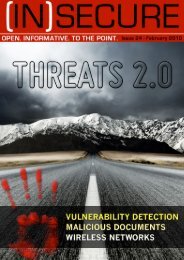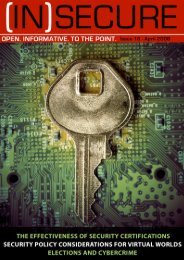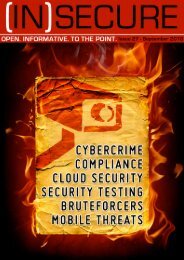You also want an ePaper? Increase the reach of your titles
YUMPU automatically turns print PDFs into web optimized ePapers that Google loves.
to externally hosted services that can provide<br />
any quantity of certificates from just a few up<br />
to large numbers. Today, internal options for<br />
hosting PKI are now bundled with major enterprise<br />
operating platforms such as Windows<br />
and IBM System z. This option is suitable for<br />
larger organizations that need to issue many<br />
certificates and that prefer to manage their<br />
certificates within their internal IT group.<br />
Choosing an external certificate source can<br />
reduce the administrative costs by removing<br />
the need to purchase and internally manage a<br />
PKI solution. This approach provides a good<br />
solution for organizations that plan to adopt<br />
certificates gradually through a pay-as-you go<br />
model and ensures certificates are associated<br />
with an established global trust source.<br />
USERS HAVING CERTIFICATES MAY STILL OFTEN USE THEM<br />
INAPPROPRIATELY<br />
Usability<br />
To some, digital certificates are still considered<br />
too difficult to use and maintain within<br />
most organizations where technical complexity<br />
of any kind introduces costly end-user<br />
training concerns. Despite the advances in<br />
available options and improvements in setting<br />
up and maintaining a PKI as a certificate<br />
source, the end-user component - digital certificates<br />
– may still be viewed as an obstacle.<br />
Too many steps and administrative touchpoints<br />
with users still exist in the delivery, use,<br />
and exchange of certificates.<br />
Opportunities for user error abound in both<br />
the enrollment and use of certificates in environments<br />
where there is user resistance to<br />
adopting a new technology - most users are<br />
comfortable with using a password for data<br />
privacy and protection, while a digital certificate<br />
is unfamiliar and is perceived as complicated.<br />
Forum panelists pointed out that one<br />
benefit offered by digital certificates is that<br />
they can be integrated more transparently into<br />
user workflows, removing the need to remember<br />
or retrieve a password. This transparency<br />
requires readily available access to<br />
both the public and private key pair of the certificate,<br />
as well as the public keys of other certificate<br />
users. Private keys may often be<br />
available only from a single system which restricts<br />
where a user may effectively use it for<br />
protecting information. Increasing availability<br />
of portable, hardened certificate storage options<br />
in the form of a smart card or smart token<br />
offer the promise to remove this restriction;<br />
however, interoperability with these devices<br />
remains limited to only a few applications<br />
today.<br />
Public key access can be impeded by limited<br />
availability of hosted public key directories.<br />
This leaves users few options other than resorting<br />
to complex, technical key exchange<br />
steps. Alternate solutions offering the promise<br />
of simplifying the use of public/private keys<br />
through easily available identifiers (e.g., email<br />
address), unfortunately, fall short as a result of<br />
their inability to scale to meet the needs of a<br />
large and often widely dispersed population of<br />
internal and external users.<br />
Management and control<br />
Managing data security across disparate applications<br />
that integrate inconsistently, if at all,<br />
with centrally issued certificates, increases<br />
the cost and complexity of administration and<br />
can leave gaps in protection. Few applications<br />
make use of certificates today for end-user<br />
encryption or authentication (digital signing),<br />
yet data often moves between different applications<br />
and passes through many hands during<br />
normal use. This presents areas of risk as<br />
data moves between users and between<br />
cross-platform and cross-vendor applications<br />
possessing varying levels of certificate support.<br />
Applications that attempt to reduce perceived<br />
end-user complexity by “hiding” their<br />
use of digital certificates inside the application<br />
provide only limited data protection - protection<br />
that is lost as the data moves beyond the<br />
boundaries of that application.<br />
Users having certificates may still often use<br />
them inappropriately. Lack of policy support to<br />
ensure appropriate use and contingency access<br />
to encrypted data complicate audit and<br />
regulatory compliance efforts.<br />
www.insecuremag.com 27





